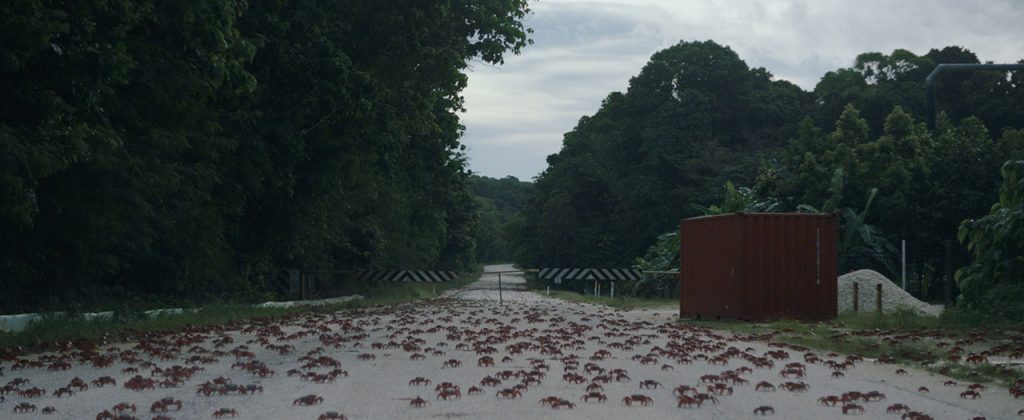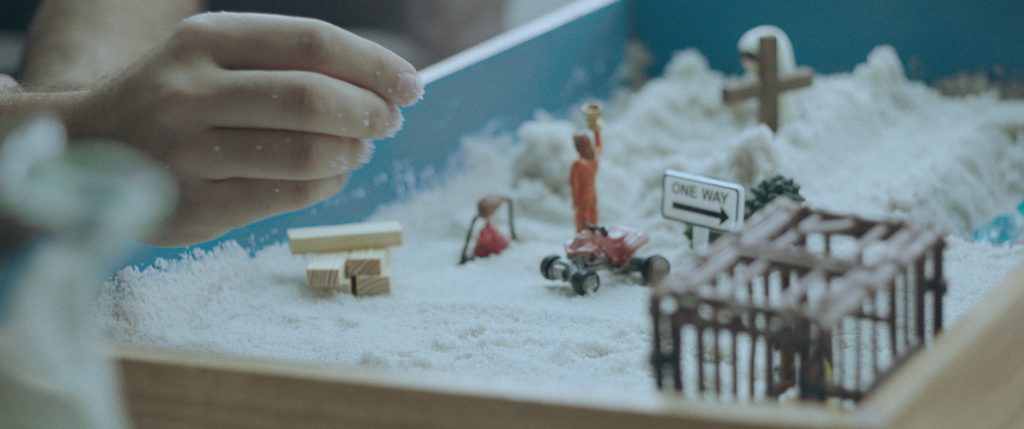Poh Lin Lee is a trauma counsellor who lives on Christmas Island with her family. Her job consists of assisting the asylum seekers who have been detained in the detention centre on the remote island. This role takes its toll on Poh, but she persists as she knows that these isolated people need her help.
This small island in the middle of nowhere is an ocean oddity – a relatively recent discovery in the realm of human history, with humans having migrated there in the last century. The previous island inhabitants still occupy the islands forests – some 40 million red land crabs whom migrate across the island to reach the treacherous shoreline. Poh, the asylum seekers, and the crabs are not alone, with a predominantly Chinese and Malay population of about two thousand people making up the ‘citizens of Christmas Island’.
This is the Island of the Hungry Ghosts.
Director Gabrielle Brady inserts moments of people burning offerings for the spirits of those who have long past and were never given a proper burial between Poh’s story and the migration of the crabs. This offering is given a greater relevance given the many asylum seekers who have died on the shores of Christmas Island, with the most notable tragedy being that of the 2010 tragedy where 48 people died off the coast of Christmas Island after their boat sank.
At its core, Island of the Hungry Ghosts is a film about the people who help those in need. Poh’s narrative carries the bulk of the thematic weight that makes this film so important and powerful, while the motif of the offerings for ‘hungry ghosts’ shows the care and sensitivity that people have for those who have long passed. Meanwhile, as the crabs make their migration across the island, people are deployed to ensure that their journey is a safe one. A team monitors the roads on the island, closing off each one to traffic as a new swathe of crabs forge a path forward in earnest. In one scene, a young bloke shows his teammate how to make a makeshift bridge to help the crabs make their way across a ditch. Later, he sweeps the crabs aside with a broom as he guides a small convoy safely through the migration path.
Meanwhile, Poh sits in her office helping refugees work through the trauma of having escaped a war torn country, all the while being kept as prisoners without any cause in a military-esque prison. She utilises a box with sand taken from the beach to help her patients tell their story. Toy figures are used to help provide a visual representation of their emotions. Some opt to simply run their fingers through the sand as they talk about the distance between them and their family. Then, like a tap being slowly turned off, the patients start to dry up. A day of therapy is made obsolete as asylum seekers are either moved off the island without any prior notice, or they are denied the ability to come to therapy.
All the while, Poh diligently stays on the island, her family by her side to support her and care for her. She carries the weight of the grief and pain that these people in need pour onto her. Yet, there’s a limit as to how much pain one person can carry, and come the films end, Poh can’t carry any more. Her ability to support the asylum seekers is being thwarted by the Australian government, their actions employed to deny the asylum seekers of any kind of support.
One sequence, perfectly captured by cinematographer Michael Latham, has Poh cutting a path through the rambling jungle. She is exhausted, sweat pours down her face. At first we think that it’s because she needs to let off steam, but at the conclusion of her journey we realise her destination was to get a glimpse of the compound that the asylum seekers are kept in. It’s a mammoth fortress made of gnarled metal. Ominous lights hang over the wire fences, working as a deterrent for anyone who wants to make their way either in or out of the facility. Poh looks over the facility, knowing that her fate is sealed, just like the fate of the asylum seekers who call it ‘home’. The Australian government has taken whatever agency these people had and has discarded it like trash.

I sat still after watching Island of the Hungry Ghosts. I want to say I felt numb, that I felt exhausted, that I felt depressed, over what I’d just seen. But the truth of the matter is – I’ve become used to this kind of story over the past five years. I’ve become accustomed to reading stories about people trying to help asylum seekers and being turned away. I’ve become accustomed to the Australian way of life – the way the government tries to gaslight Australia into thinking that they’re doing the right thing by keeping asylum seekers locked up in far off prisons without the necessary care, and definitely without any compassion at all.
I don’t want you to think that after watching Island of the Hungry Ghosts that I had become complacent and accepting that this is the fate of the world. Far from it.
I was furious.
I sat on the edge of my seat stirring in a mire of anger and hurt.
The comparison that Gabrielle Brady is making is clear – how can one community offer care and support for spirits that have passed, and another provide care and support for migrating crabs, all the while, in the same vicinity, a government decides that these people in need are worth nothing and have no right to asylum? The Australian government decides that indefinite detention is the best thing for these asylum seekers, hiding behind the narrative that ‘lives are saved because less people are drowning at sea’, but as one refugee states as they voice that they’ve contemplated suicide, ‘when your life is the only thing you have a choice over, you’d probably be contemplating it too’.
Recently, the medical officers on Nauru were removed from the island. Médecins Sans Frontières had been providing psychological assistance to asylum seekers, only for their services to be denied by the Nauruan government. While Poh decides to leave Christmas Island for her own mental health, it’s clear that she does so reluctantly. The Australian government had simply made her role as a counsellor untenable. By denying her the ability to care for those in need, and in turn, denying those in need the ability to move out of detention and into the community, the government enacts a cycle of trauma that shows no sign of ceasing.
Australia has produced many films about asylum seekers and refugees. Eva Orner’s Chasing Asylum takes viewers into the camps on Manus and Nauru and shows the horrendous living conditions of those being kept in perpetuity. Judy Rymer’s Border Politics has human rights barrister Julian Burnside travelling the world and witnessing the way society at large is treating asylum seekers. Belinda Mason’s Constance on the Edge shows the value of Sudanese refugees in society, how they manage to forge a life for themselves all the while processing residual trauma from the world they escaped. Ros Horin’s The Baulkham Hills African Ladies Troupe shows the value of telling these stories, both for the world at large, and for those whose story it is to tell. Gabrielle Brady’s Island of the Hungry Ghosts sits comfortably amongst this group of powerful, essential films about a worldwide, unceasing tragedy. These stories need to be told, and it’s with great thanks to these great women directors that they are being told right now.
It’s worthwhile circling out two groups within Australia that are driven by strong women helping those in need: Grandmothers Against Detention of Refugee Children and Sister Works. Please visit their sites and support them where you can. Please also consider supporting the Asylum Seeker Resource Centre.
Director: Gabrielle Brady



